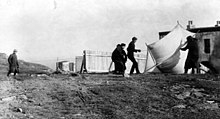Signal Hill (Newfoundland)
The Signal Hill is a hill on the Newfoundland Atlantic coast , on the north side of the harbor entrance of St. John's . A few kilometers south is Cape Spear , the easternmost point in North America.
Due to its strategically important location, there were fortifications on the hill as early as the middle of the 17th century. The last battle of the Seven Years' War on North American soil, in which France lost St. John's to Great Britain, was fought on Signal Hill. The British Colonel William Amherst renamed the hill previously known as "The Lookout" to "Signal Hill", as signals for incoming ships and the city were given from a flagpole.
A citadel was built when Signal Hill was first built at the end of the 18th century . Troops were stationed on the hill during the Napoleonic Wars and the War of Civil Secession in the 19th century. This was followed by the construction of the Queen's Battery Barracks , which have now been rebuilt to the status of 1862. Between 1870 and 1920 there were three different hospitals on Signal Hill, all of which were destroyed by fires. In one of these hospitals, Guglielmo Marconi received the first transatlantic radio signal on December 12, 1901. In 1897 construction began on the Cabot Tower , which was officially opened in 1900. Anti-aircraft guns were stationed on Signal Hill during World War II .
Today, the hill is part of the Signal Hill National Historic Site of Canada , a memorial under the administration of Parks Canada , and one of St. John's attractions with visitor center and hiking trails.
Web links
- Signal Hill National Historic Site of Canada (English)
- Marconi's First Transatlantic Wireless experiment (English)
Coordinates: 47 ° 34 ′ 8 " N , 52 ° 40 ′ 49" W.



